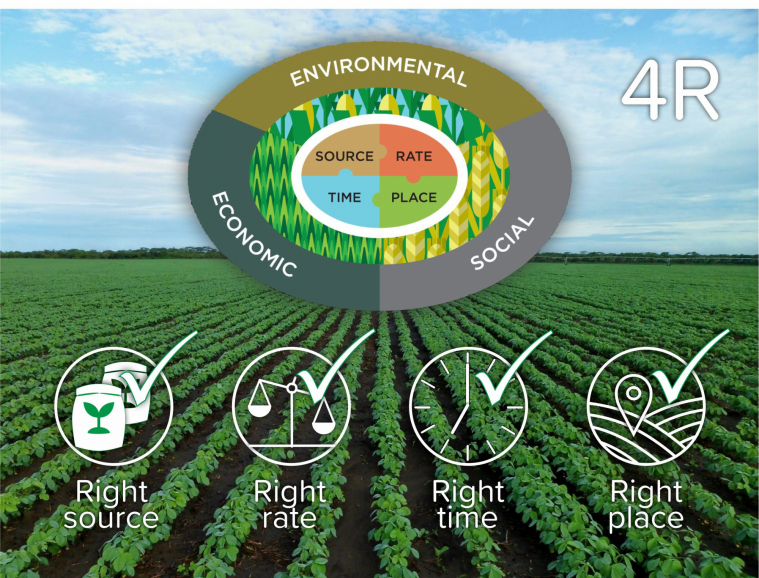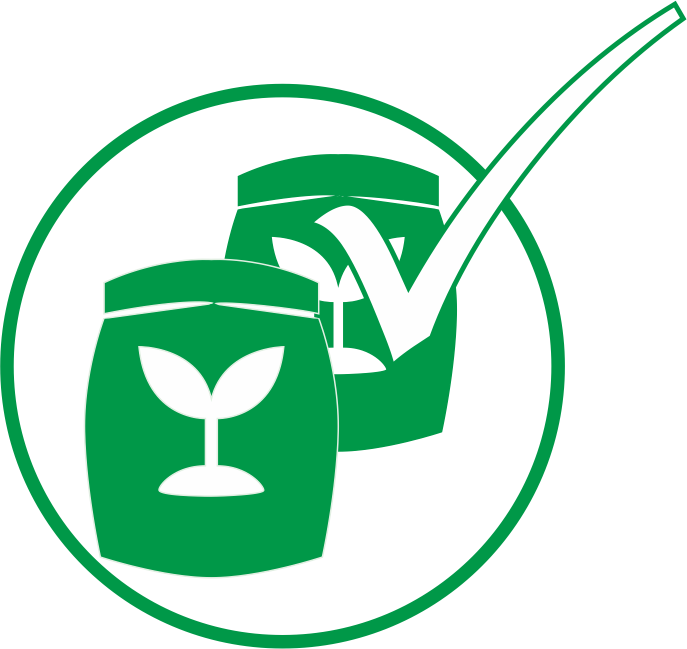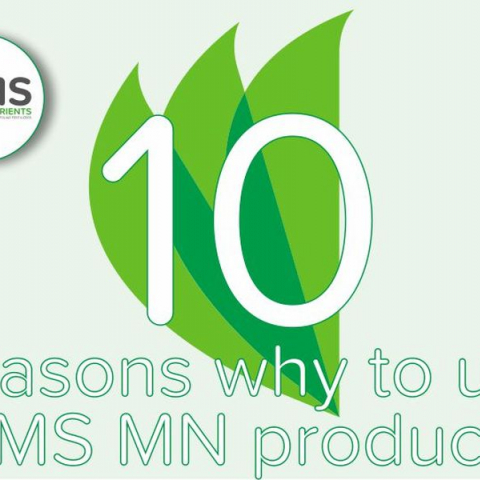You are here
Foliar fertilisation and the “4R” technique/guidelines

The world fertilizer industry introduced the “4R Nutrient Management” principle with the aim to make the agricultural system more sustainable. The Right source, Right rate, Right timing and Right placement of the fertilizers has to increase the efficiency of the fertilisation.
BMS Micro-Nutrients believes that foliar fertilisation (full comprehensive programmes with all nutrients and the micronutrients in the chelated form) deserves a more prominent role within this concept. Full foliar programmes is nothing else then the “4R-principles” pushed to their limits with maximum benefits for the environment and reduced carbon footprint.
Fertilisation has an enormous impact on production and profitability of our agronomic system. Fertilizers are essential for farms to produce sufficiently and in a profitable way, keeping quality food accessible for everybody. The “4R best fertilization best management practices” was developed by the world fertiliser industry to understand and verify in a quick and efficient way if the applied fertilisation is optimal. Optimal in all its economic, social and as well environmental aspects.
- Economic aspects: profitability, return on investment, quantity and quality of the yield (also seen over several years), ….
- Social aspects: farm income, working conditions, affordable food, ….
- Environmental aspects: use of resources, carbon footprint (CO2 emissions), soil and water contamination, nutrient losses, energy use,…
The 4R’s of these management practices signify “right source”, “right rate”, “right place” and “right time” and aim to increase the efficiency of the fertilisation. Naturally everybody is in favour of optimising, improving and increasing efficiency, but the guidelines which are now in place are unfortunately still based on traditional soil fertilisation, and aim mainly to improve the efficiency of this “old” way of applying fertilizers, instead of rethinking the whole concept of fertilisation. The efficiency of fertilisation in general can be improved much more by also giving foliar fertilisation its well-deserved place within these management practices. Complete foliar fertilisation programmes in which as well mayor elements (N, P, K), secondary elements (Ca, Mg, S) as micronutrients (B, Cu, Fe, Mn, Mo, Zn) are applied, have proven to be very efficient, and will reduce the need of soil fertilisation! The reduction of soil fertilizers can be from 15-20 % up to the full 100% even if a the soil fertilisation is well managed and following the 4R best practices.
BMS Micro-Nutrients’ mission statement and objective is to bring nutrients to the plant in the most efficient way so that a minimum amount of fertilizers need to be used, which is completely in line with the “4R Nutrients Management system”. Thanks to the high quality and high plant availability of the BMS Micro-Nutrients products, the custom made full foliar nutritional programmes will push the “4R management practices” to its limits. This is why:
1. Right source:
 The best source (= chemical form of the nutrient) is the source with the highest plant availability. Availability is strongly linked its solubility, and possibility to stay soluble for a long enough time after the moment of application, so that the plant has the possibility to absorb it. With foliar applications this period is very short. The foliar applied elements are relatively well absorbed if applied in a solution. Translocation can still be a problem (see further on).
The best source (= chemical form of the nutrient) is the source with the highest plant availability. Availability is strongly linked its solubility, and possibility to stay soluble for a long enough time after the moment of application, so that the plant has the possibility to absorb it. With foliar applications this period is very short. The foliar applied elements are relatively well absorbed if applied in a solution. Translocation can still be a problem (see further on).
On the other hand, when nutrients are applied to the soil this period can be days, weeks or even months. Soils are complex chemical environments with a lot of interactions between the different component. Unfortunately a lot of these interactions reduce their solubility and thus their availability for the crops, for example:
- A high soil pH will reduce availability of phosphorous and most micronutrients.
- Potassium can be fixed on soils with a high clay content,
- Elements can be released or fixed by organic material.
- Interactions between different nutrients can also reduce some availabilities as for example the excess of P reduces the soil availability of Zn, the excess of K fertilisation reduces Ca, and or Mg availability….
On the other hand highly soluble, and thus plant available, nutrients such as nitrates, can be lost easily by leaching and run-off, contaminating the surface and ground waters.
For trace elements the availability can be increased immensely by chelating them. Chelates will protect the micronutrients against secondary reactions and keep them soluble. Chelates have advantages for all types of applications, but applied foliar they are not only better absorbed then salts but the biggest advantage is that they have a good translocation within the plant, nourishing thus the whole plant and not only the leaves on which the nutrient solution is applied. The foliar application of chelated trace elements, is the most efficient way to apply these nutrients. Smaller amounts are necessary and thus less resources (coming often from mining, an environmental devastation activity) are required.
The chelates of BMS Micro-Nutrients are unique formulations on the market, making them the best plant available products on the market. More about this you can find out on our website: www.chelal.com
2. Right rate:
 The calculation of the right rate has to be done based on the nutrient balance of the field. The crop and the expected yield will determine the amount of nutrients that need to be available. On the other hand we need to examine carefully the nutrients available based on soil analysis (soil reserves) and all the different nutrients inputs, such as crop residues, organic inputs, atmospheric deposition and nutrients present in irrigation water, etc…. These inputs are often under estimated, certainly in perennial plants, were roots can reach deep soil layers. Also the availability and the use efficiency by the crop of the inputs and soil reserves needs to be taken into account as well. Finally the difference between the crop requirements and the available nutrients will need to be made up by fertilisation in one way or another, to the soil and/or foliar.
The calculation of the right rate has to be done based on the nutrient balance of the field. The crop and the expected yield will determine the amount of nutrients that need to be available. On the other hand we need to examine carefully the nutrients available based on soil analysis (soil reserves) and all the different nutrients inputs, such as crop residues, organic inputs, atmospheric deposition and nutrients present in irrigation water, etc…. These inputs are often under estimated, certainly in perennial plants, were roots can reach deep soil layers. Also the availability and the use efficiency by the crop of the inputs and soil reserves needs to be taken into account as well. Finally the difference between the crop requirements and the available nutrients will need to be made up by fertilisation in one way or another, to the soil and/or foliar.
For a lot of nutrients, certainly micro nutrients (or trace elements), foliar fertilisation can be the only solution. The quantities needed of these nutrients (from 2-5 gr for Molybdenum to 1-2 kg for Iron) are so low that the total amount necessary can be applied easily foliar. For other nutrients, secondary and mayor elements, foliar applications can be very helpful to support the crops and avoid or cure deficiencies. Take into account that crops with deficiencies of for example P, have a certain amount of this element already absorbed. They just need to be supplemented with an extra amount of the element in order to cure the deficiency. It is not necessary to apply the full needs of the crop. These smaller quantities can often be applied foliar!
Foliar fertilisation also stimulates the plant to develop a bigger and voluminous root system. It is able to explore a bigger volume of soil, and therefore it can absorb better and more efficiently the reserves of the soil, reducing the need of applying even more fertilisers to the soil (in the nutrient balance more elements are available). Another advantage of this more voluminous root system is that the plant can also reach more water reserves, making it a bit more drought resistant.
Many trials done by BMS Micro-Nutrients have shown that with its foliar programmes the soil fertilisation can be reduced strongly. The environmental benefits of this reduction is that the Carbon footprint of the fertilisation can be reduced up to more than 90 %. Other benefits are less water and soil contamination, and logistic advantages of less movement and manipulation of fertilisers.
All these benefits come together in our ECOMETHOD programme. Farmers following the guidelines of this programme can obtain a declaration of their reduced carbon footprint for a specific crop and field in a given year (read more on: www.ecomethod.eu).
3. Right time:
 This is the most difficult aspect to control with the traditional soil fertilisation. As we all know during plant development its requirements for nutrients change. In the early stages plants need more Nitrogen, Phosphorous and for example Zinc. In later stages, plants have more needs for Calcium and certainly Potassium in fruit bearing crops.
This is the most difficult aspect to control with the traditional soil fertilisation. As we all know during plant development its requirements for nutrients change. In the early stages plants need more Nitrogen, Phosphorous and for example Zinc. In later stages, plants have more needs for Calcium and certainly Potassium in fruit bearing crops.
Some practices can be implemented to improve the availability at the right time. Traditionally fertilisers are applied at the beginning of the season before planting. The availability at the right moment is not assured and cannot be controlled or modified during the season. Fertigation, fractioning and the application of certain elements at certain moments, as also the use of slow release fertilisers are important techniques to improve the timing of the availability of nutrients to the crops. Unfortunately once the nutrients arrive in the soil, we don’t have any control anymore on what happens further with them.
- Do the elements stay plant available are not? There might be an interaction with the soil after application maybe due to a high soil pH, making them unavailable.
- Are the nutrients in the reach of the roots? The nutrients might leach with the irrigation (or rain) water?
- Is it still the right moment for absorption? Mineralisation of organic matter/fertilizers with the consequent release of N reaches often its peak, after the period of high plant requirements!
- Are the surrounding conditions good for absorption by the plant? For example cold weather in early plant development stages will reduce availability of the highly needed P and Zn at this moment ….
With foliar applications you can apply a specific nutrient on an exact moment, exactly when the crop needs them (or maybe better, just a little bit before, so that the plant is well prepared). Plants are almost forced to absorb the foliar applied nutrients, so that they can be incorporated immediately into the metabolism of the plant. It assures that the plants has the right nutrients at the right moment.
In case of deficiencies appearing during the growth cycle, it is import to act swiftly and immediately, in order to avoid any growth interruption, often having an immediate and direct influence on the yield. Only foliar applications can guarantee such a quick effect.
4. Right place:
 The first and only goal of fertilisation is to nourish plants for optimal growth and production. So which place can be better than the plant itself, to apply its nutrients. Leaves are not the only metabolically active organs, but they are certainly the most active ones, where the needs of nutrients is extremely high. Giving nutrients to the leaves will activate and facilitate a lot of processes taking place there and having a direct effect on growth, plant development and production.
The first and only goal of fertilisation is to nourish plants for optimal growth and production. So which place can be better than the plant itself, to apply its nutrients. Leaves are not the only metabolically active organs, but they are certainly the most active ones, where the needs of nutrients is extremely high. Giving nutrients to the leaves will activate and facilitate a lot of processes taking place there and having a direct effect on growth, plant development and production.
As we have seen, soil applications are often not very efficient, also because roots do not explore 100 % of the soil volume. We can naturally try to put the fertilisers as best as possible close to the roots, in a chemical form that does not interact to much with the soil in the right amounts, but this is still all not so efficient as applying the nutrients onto the crop itself!
From all the above it clear that foliar fertilisation needs more attention and a more prominent place in our approach to more sustainable fertilisation. Although sometimes total foliar fertilisation is possible, it is not a substitution of soil fertilisation in all circumstances, all crops and all situations. Nevertheless it ALWAYS deserves to be part of the total fertilisation programme. It can, is and must be a valuable additional tool, which we have to our disposal to fertilise in a more sustainable way.
Climate change with its devastating effects, is forcing all industries, including agriculture to produce more sustainable and carbon neutral. Carbon storage alone will not be enough. We will need to work on all aspects of farm production, including the aspect of fertilisation. Foliar fertilisation can help us with it! The big advantage of foliar fertilisation is that it is a technique that is immediately applicable, it is not a new technique that still needs to be developed scientifically, and proof its value. NO, it is available and is can be applied. So let us do it with the best products possible. If you need any help to develop a foliar programme for your crop, enter in contact with the technical team of BMS Micro-Nutrients, we will be glad to assist.
